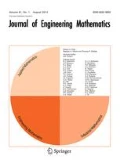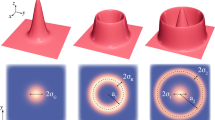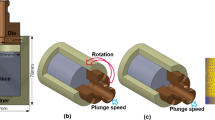Abstract
In this paper we derive realistic simplified models for the high-speed drawing of glass optical fibres via the downdraw method that capture the fluid dynamics and heat transport in the fibre via conduction, convection and radiative heating. We exploit the small aspect ratio of the fibre and the relative orders of magnitude of the dimensionless parameters that characterize the heat transfer to reduce the problem to one- or two-dimensional systems via asymptotic analysis. The resulting equations may be readily solved numerically and in many cases admit exact analytic solutions. The systematic asymptotic breakdown presented is used to elucidate the relative importance of furnace temperature profile, convection, surface radiation and conduction in each portion of the furnace and the role of each in controlling the glass temperature. The models derived predict many of the qualitative features observed in real industrial processes, such as the glass temperature profile within the furnace and the sharp transition in fibre thickness. The models thus offer a desirable route to quick scenario testing, providing valuable practical information about the dependencies of the solution on the parameters and the dominant heat-transport mechanism.










Similar content being viewed by others
Notes
The constant \(T_\mathrm{f}\) case is amenable to phase-plane analysis, details of which may be found in the appendix.
We choose this particular form by analogy with the solution to the case where \(\mathcal{T }(\zeta )=\mathcal{T }\) (a constant), where it is clear that the solution is of the form \(T^{(0)}(x,\zeta )=\mathcal{T }+\displaystyle \sum _{m=1}^\infty f_m(\zeta )J_0(\lambda _m x),\) with a simpler form for \(f_m.\)
References
Carslaw HS, Jaeger JC (1959) Conduction of heat in solids, 2nd edn. Clarendon Press, Oxford
Cheng C, Jaluria Y (2007) Modeling of radiation heat transfer in the drawing of an optical fiber with multilayer structure. ASME J Heat Transf 129:342–352
Cummings LJ, Howell PD (1999) On the evolution of non-axisymmetric viscous fibres with surface tension, inertia and gravity. J Fluid Mech 389:361–389
Filippov A (2011) 27th mathematical problems in industry workshop. Private communication
Fitt AD, Furusawa K, Monro TM, Please CP, Richardson DJ (2002) The mathematical modelling of capillary drawing for holey fibre manufacture. J Eng Math 43:201–227
Forest GM, Zhou H (2001) Unsteady analyses of thermal glass fibre drawing processes. Eur J Appl Math 12:479–496
Frank M, Klar A (2011) Radiative heat transfer and applications for glass production processes. In: Mathematical models in the manufacturing of glass, Lecture Notes in Mathematics. Springer, pp 57–134
Geyling FT, Homsy GM (1980) Extensional instabilities of the glass fibre drawing process. Glass Technol 21:95–102
Huang H, Miura RM, Wylie JJ (2008) Optical fiber drawing and dopant transport. SIAM J Appl Math 69:330–347
Hyun JC (1978) Theory of draw resonance: part I. Newtonian fluids. AIChE J 24:418–422
Lee SHK, Jaluria Y (1997) Simulation of the transport processes in the neck-down region of a furnace drawn optical fiber. Int J Heat Mass Transf 40:843–856
Lentes FT, Siedow N (1999) Three-dimensional radiative heat transfer in glass cooling processes. Glastech Ber Glass Sci Technol 72:188–196
Myers MR (1989) A model for unsteady analysis of preform drawing. AIChE J 35:592–602
Paek UC, Runk RB (1978) Physical behavior of the neck-down region during furnace drawing of silica fibers. J Appl Phys 49:4417–4422
Papamichael H, Miaoulis IN (1991) Thermal behavior of optical fibers during the cooling stage of the drawing process. J Mater Res 6:159–167
Renardy M (2006) Draw resonance revisited. SIAM J Appl Math 66:1261–1269
Roy Choudhury S, Jaluria Y (1998) Thermal transport due to material and gas flow in a furnace for drawing an optical fiber. J Mater Res 13:494–503
Roy Choudhury S, Jaluria Y, Lee SH-K (1999) A computational method for generating the free-surface neck-down profile for glass flow in optical fiber drawing. Numer Heat Transf Part A 35:1–24
Scheid B, Quiligotti S, Tranh B, Gy R, Stone HA (2010) On the (de)stabilization of draw resonance due to cooling. J Fluid Mech 636:155–176
Suman B, Kumar S (2009) Draw ratio enhancement in nonisothermal melt spinning. AIChE J 55:581–593
Suman B, Tandon P (2010) Fluid flow stability analysis of multilayer fiber drawing. Chem Eng Sci 65:5537–5549
Wylie JJ, Huang H (2007) Extensional flows with viscous heating. J Fluid Mech 571:359–370
Wylie JJ, Huang H, Miura RM (2007) Thermal instability in drawing viscous threads. J Fluid Mech 570:1–16
Yin Z, Jaluria Y (1997) Zonal method to model radiative transport in an optical fiber drawing furnace. ASME J Heat Transf 119:597–603
Yin Z, Jaluria Y (2000) Neck down and thermally induced defects in high-speed optical fiber drawing. ASME J Heat Transf 122:351–362
Acknowledgments
This paper was conceived as an extension to a problem considered at the 27th Annual Workshop on Mathematical Problems in Industry held at the New Jersey Institute of Technology in June 2011, with funding from the National Science Foundation. We would like to thank A. Filippov from Corning Inc., who presented the problem at the workshop and gave us invaluable insight into the practical issues involved. We would also like to thank the other participants who worked on different aspects of the problem: R. Beckham, M. Gratton, M. Kanoria, K. Kilgore, V. Lapin, T-S. Lin, M. Ma, H. Nganguia, J. Pohlmeyer, H. Potter, D. Schwendeman, S. K. Wilson, and H. Yaple. Finally, the authors note that this publication was based on work supported in part by Award No. KUK-C1-013-04, made by King Abdullah University of Science and Technology (KAUST).
Author information
Authors and Affiliations
Corresponding author
Appendix
Appendix
1.1 Phase plane analysis at constant furnace temperature
As noted in the main text, system (18a,b) is amenable to a phase plane analysis in the case where the furnace temperature \(T_\mathrm{f}\) is assumed constant (for consistency with the assumption of §2.1.4 the ambient temperature \(T_\mathrm{a}\) is then also constant). Dropping all leading-order \(^{(0)}\) superscripts to simplify notation, it proves convenient to consider the phase plane in \((w,\mu )\)-space. With \(T(\mu )\) given by inverting relation (14), the autonomous system (18a,b) then becomes
with \(T(\mu )=(1+\log (\mu ) /32)^{-1}.\) The phase plane for this system is the solution trajectories of the ordinary differential equation
As in the main text, we can consider either constant \(\alpha , \,\beta ,\) or \(\alpha (w), \,\beta (w)\) as in, for example, Eq. (22). Here we present two representative example phase planes for the case in which \(\alpha \) and \(\beta \) are functions of \(w.\) A key factor influencing the qualitative features of the phase diagram is whether the ambient temperature \(T_\mathrm{a}\) is greater than or less than the glass-softening temperature. In Fig. 11 we show the phase plane for \(\alpha =\alpha _0 (1-\exp (-10/\sqrt{w})), \,\beta =\beta _0 w^{2/3},\) and with \(\alpha _0=160, \beta _0=1, \,T_\mathrm{f}=1.57,\,T_\mathrm{a}=0.75\) (lower than the glass-softening temperature, which normalizes to 1), and \(\text{ Pe}^* F =3840.\) The solid curves are the phase trajectories, while the dashed curve is the nullcline on which \( \alpha (T(\mu ) ^4-T_\mathrm{f}^4) +\beta (T (\mu )-T_\mathrm{a}) =0.\) Only a limited range of the \(\mu \)-axis is shown for simplicity, but it is clear what the evolution would be for such a fibre. The fibre enters at a small value of \(w,\) the input velocity. At this stage its viscosity is extremely large. As the fibre enters further into the furnace it gains axial velocity and its viscosity drops precipitously before levelling off. Depending on the draw ratio (ratio of exit velocity to input velocity), the viscosity may reach a minimum value (phase path crossing a nullcline) and then increase again before the fibre exits the furnace.
In the case where the ambient temperature \(T_\mathrm{a}\) is higher than the softening temperature, the evolution is less dramatic. An example is shown in Fig. 12, with all parameters as before except \(T_\mathrm{a} =1.18 >1.\) In this case, the viscosity again drops rapidly as the fibre enters the furnace, but then stays at a low value until exit.
Bearing in mind the comments of §4.1.2 about the unrealistic nature of the proposed functional dependence of \(\beta ,\) we also show a phase plane for the case of constant \(\beta =50\) (Fig. 13). In this case the phase plane shows no qualitative difference between the cases where the ambient temperature is above or below the softening temperature, so we show only the case considered throughout most of the paper, where \(T_\mathrm{a} = 3T_\mathrm{f}/4=1.18 >1\) (and all other parameters are as above). The fibre viscosity now decreases monotonically as the fibre passes through the furnace, for all draw ratios.
Rights and permissions
About this article
Cite this article
Taroni, M., Breward, C.J.W., Cummings, L.J. et al. Asymptotic solutions of glass temperature profiles during steady optical fibre drawing. J Eng Math 80, 1–20 (2013). https://doi.org/10.1007/s10665-013-9623-z
Received:
Accepted:
Published:
Issue Date:
DOI: https://doi.org/10.1007/s10665-013-9623-z







